Reproducible Research: Quest for the Ground Truth
Reproducible Research: Quest for the Ground Truth
Combined Educational & Scientific Session
Combined Educational & Scientific Session
ORGANIZERS: Lijun Bao, Tony Stoecker
Thursday, 16 May 2019
| Room 710A | 13:45 - 15:45 | Moderators: Chunlei Liu, Ingolf Sack |
Skill Level: Basic to Advanced
Session Number: TH-06
Overview
Especially in quantitative MRI applications, ground truth knowledge is required to validate novel methodologies. The course will give an overview of methods to validate reproducibility in qMRI. Several examples will be discussed how to generate ground truth data in quantitative MRI.
Target Audience
Everyone interested in understanding and generating ground truth data for the validation of quantitative MRI methodology.
Educational Objectives
As a result of attending this course, participants should be able to:
- Describe methods to evaluate reproducibility;
- Recognize the difference between accuracy and precision; and
- Describe methods to generate ground truth data such as phantoms, complementary methods, and simulations.
Overview
Especially in quantitative MRI applications, ground truth knowledge is required to validate novel methodologies. The course will give an overview of methods to validate reproducibility in qMRI. Several examples will be discussed how to generate ground truth data in quantitative MRI.
Target Audience
Everyone interested in understanding and generating ground truth data for the validation of quantitative MRI methodology.
Educational Objectives
As a result of attending this course, participants should be able to:
- Describe methods to evaluate reproducibility;
- Recognize the difference between accuracy and precision; and
- Describe methods to generate ground truth data such as phantoms, complementary methods, and simulations.
| 13:45 |
|
How to Assess Accuracy & Reproducibility in qMRI
Kathryn Keenan
In this talk, we'll discuss the design of repeatability and reproducibility studies in home-built phantoms, standard phantoms and in vivo on our quest for ground truth.
|
| 14:15 |
|
Magnetic Susceptibility in Tissue: What It Is & How to Measure
Richard Bowtell
This talk will describe: what magnetic susceptibility is; how we measure magnetic susceptibility using MRI; and some ways of validating methods for measuring magnetic susceptibility.
|
14:45 |
1120. 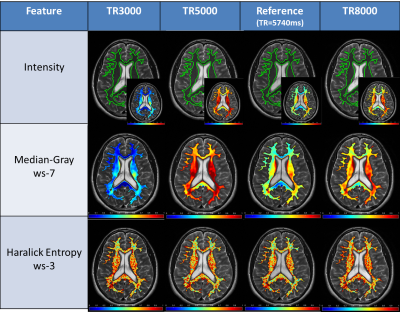 |
Evaluating the influence of contrast weighting, resolution, and parallel imaging on the reproducibility and tissue specificity of radiomic features
Brendan Eck, Prathyush Chirra, Kaustav Bera, Nitya Talasila, Pallavi Tiwari, Anant Madabhushi, Satish Viswanath, Nicole Seiberlich
Computer-extracted (radiomic) features can provide a wealth of quantitative information that is useful for quantitative characterization of disease. However, routine image acquisition parameters can vary substantially across patients with the potential to confound or degrade results obtained by analysis of radiomic features. The extent to which the variation in routine image acquisition parameters can affect radiomic features in vivo is not well known. In this work, we evaluate the influence of varied contrast weighting (TR, TE), varied resolution, and the use of parallel imaging on intensity and textural radiomic features in T2-weighted images.
|
14:57 |
1121. 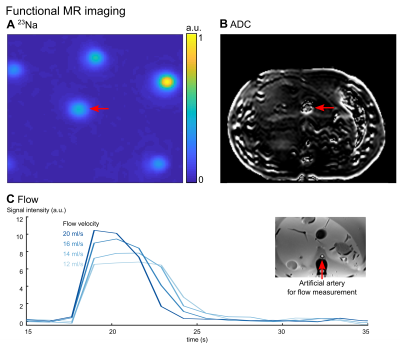 |
A multiparametric (1H, 23Na, diffusion, flow) anthropomorphic abdominal phantom for multimodal MR and CT imaging
Wiebke Neumann*, Tanja Uhrig*, Nadia Paschke, Marius Siegfarth, Andreas Rothfuss, Gordian Kabelitz, Khanlian Chung, Alena-Kathrin Schnurr, Lothar Schad, Jan Stallkamp, Frank Zöllner
Anthropomorphic phantoms are essential for the evaluation of image registration algorithms in multimodal imaging, quantification experiments in multinuclear MR imaging, and verification of diffusion and flow measurements. A human-like abdominal phantom incorporating a liver with lesions, a rib cage, vessels, and a lung was developed. Its tissue-mimicking characteristics were evaluated with 1H and 23Na MR and CT imaging as well as functional flow and diffusion MR imaging. The phantom exhibited morphological and functional parameters comparable to corresponding human values. It is suitable for a quantitative evaluation of a clinical workflow ranging from diagnostics to interventional procedures.
|
| 15:09 |
1122. 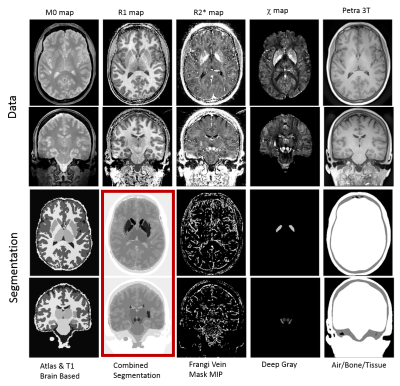 |
Towards QSM Challenge 2.0: Creation and Evaluation of a Realistic Magnetic Susceptibility Phantom
José Marques, Berkin Bilgic, Jakob Meineke, Carlos Milovic, Kwok-shing Chan, Wietske van der Zwaag, Renaud Hedouin, Christian Langkammer, Ferdinand Schweser
We present the creation of a modular and realistic digital phantom to serve as a ground-truth to assess the quality of different reconstruction algorithms for Quantitative Susceptibility Mapping (QSM). The phantom is derived from high-resolution, quantitative MRI data of a healthy volunteer, features a realistic morphology including a non piece-wise constant susceptibility distribution. Varying degrees of complexity can be realized, for example by adding the effects of tissue microstructure, down sampling or adding background-fields. The freely available phantom will be used in the upcoming QSM Reconstruction challenge.
|
15:21 |
1123. 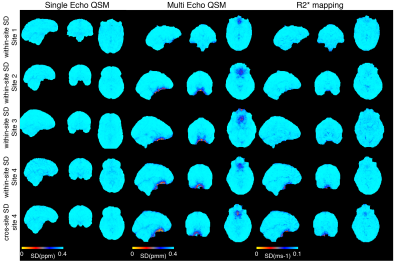 |
QSM and R2* measurements from cortical and subcortical regions of the human brain at 7T: a Multi-Centre Reproducibility Study
Catarina Rua, William Clarke, Ian Driver, Olivier Mougin, Andrew Morgan, Stuart Clare, Sue Francis, Keith Muir, David Porter, Richard Wise, Adrian Carpenter, Guy Williams, Christopher Rodgers, Richard Bowtell
Multi-site studies allow for cost-effective research at high-field by increasing the size of the healthy and patient pool.
For T2*-weighted imaging, the variability in the scanners’ shimming conditions may contribute to inconsistent numerical results.In this study we present a multi-site, multi-vendor ‘travelling-heads’ study with harmonized protocols for QSM and R2*-mapping. Average values across cortical and subcortical ROIs are in agreement with literature, show low variance and high correlation values when comparing measurements across different scanners. R2*-mapping is more stable than QSM due to shimming differences across scanners that affect the background field. |
| 15:33 |
1124. 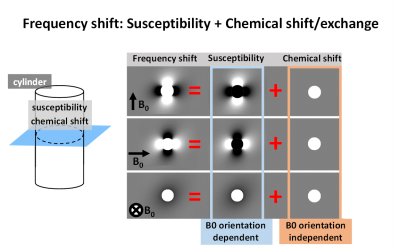 |
Separating chemical shift/exchange from magnetic susceptibility in a phantom
Hyunsung Eun, Jingu Lee, Woojin Jung, Hyeong-Geol Shin, Jongho Lee
We proposed a new method that separates susceptibility-induced frequency shift from chemical shift/exchange-induced frequency shift in a phantom using three axes scanned datasets. The method was successfully validated in numerical simulation and phantoms and reported susceptibility and chemical shift/exchange in vegetable oil (susceptibility: 0.66±0.02 ppm; chemical shift: 3.58±0.01 ppm) and iron oxide (concentration: 0.025%; susceptibility: 0.30±0.02 ppm; chemical exchange: 0.039±0.003 ppm).
|
| 15:45 |
|
Adjournment |
 Back to Program-at-a-Glance |
Back to Program-at-a-Glance |  Back to Top
Back to Top